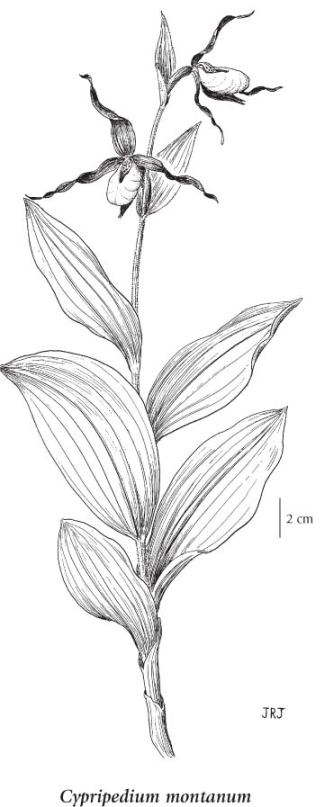Cypripedium montanum Douglas ex Lindl.
mountain lady's slipper (white lady's-slipper)
Orchidaceae (Orchid family)
Introduction to Vascular Plants
mountain lady's slipper (white lady's-slipper)
Orchidaceae (Orchid family)
Introduction to Vascular Plants
Introduction
Mountain lady's slipper is a wild orchid species found in western North America where it has been reported in the United States from Alaska, California, Idaho, Montana, Oregon, Washington and Wyoming, and in Canada from British Columbia, Alberta and Saskatchewan (USDA 2011). It is found throughout British Columbia (rare or infrequent, rare in northern BC), where it occurs in moist to dry open forests in the steppe, montane and subalpine zones from 0 to 2400 m (Flora North America 2011). It may be found in a range of conditions, from full shade to almost full sun (Luer 1975) This is a rhizomatous species with four to six pubescent leaves and one to three flowers at the end of each stem. Sepals and petals are green to brown, petals are twisted, lip is white, egg-shaped and streaked with purple. Flowering occurs from February to September over its range. Hybrids with Cypripedium parviflorum have been reported.
Read a description of this species in Flora North America. View photos of the lady's slipper orchids of British Columbia. |
Species Information
General:
Perennial herb from stout rhizomes, with coarse, fibrous roots; stems 25-70 cm tall, glandular-hairy, leafy.
Leaves:
Stem leaves 4 to 6, egg-shaped to elliptic-lanceolate, 5-16 cm long, 2.5-8 cm wide, ribbed, the base sheathing.
Flowers:
Inflorescence of 1 to 3 showy flowers; sepals brownish-purple to dark green with purple splotches, lanceolate, twisted, 3-6 cm long, 1-2 cm wide, the lower sepals united, pendant behind lip; petals similar to sepals; lip egg-shaped, 2-3 cm long, 1.5 cm wide and deep, white with purple veins.
Fruits:
Capsules, nearly erect, narrowly ellipsoid, ribbed, glandular-hairy.
Notes:
C. x columbianum Sheviak, a hybrid of C. montanum and C. parviflorum var. pubescens, is known from BC and the adjacent NW U.S.A. The type specimen for the hybrid was collected in BC (Sheviak 1992). The hybrids are either intermediate between the two species or have a mix of characteristics of each.
Illustration

If more than one illustration is available for a species (e.g., separate illustrations were provided for two subspecies) then links to the separate images will be provided below. Note that individual subspecies or varietal illustrations are not always available.
Illustration Source: The Illustrated Flora of British Columbia
Ecology
Ecological Framework for Cypripedium montanum
The table below shows the species-specific information calculated from
original data (BEC database) provided by the BC Ministry of Forests and Range.
(Updated August, 2013)
The table below shows the species-specific information calculated from
original data (BEC database) provided by the BC Ministry of Forests and Range.
(Updated August, 2013)
| Site Information |
Value / Class |
||
|
Avg |
Min |
Max |
|
| Elevation
(metres) |
794 | 170 | 1709 |
| Slope
Gradient (%) |
25 | 0 | 74 |
|
Aspect (degrees) |
205 | 45 | 344 |
| Soil
Moisture Regime (SMR) [0 - very xeric; 4 - mesic; 8 - hydric] |
3 | 2 | 7 |
| Modal
Nutrient Regime
Class |
C | ||
| #
of field plots species was recorded in: |
35 | ||
| Modal
BEC Zone Class |
IDF | ||
|
All BEC Zones (# of stations/zone) species was recorded in |
BWBS(4), CWH(1), ESSF(1), ICH(9), IDF(10), SBS(9) | ||
|
Source:
Klinkenberg 2013
|
|||
Habitat and Range
Moist to dry open forests in the steppe, montane and subalpine zones; rare on N Vancouver Island, infrequent in and E of the Coast-Cascade Mountains, rare northward; N to AK, E to SK and S to WY, ID and CA.Status Information
References
Luer, Carlyle A. 1975. The Native Orchids of the United States and Canada, Excluding Florida. W. S. Cowell Ltd, Ipswich.